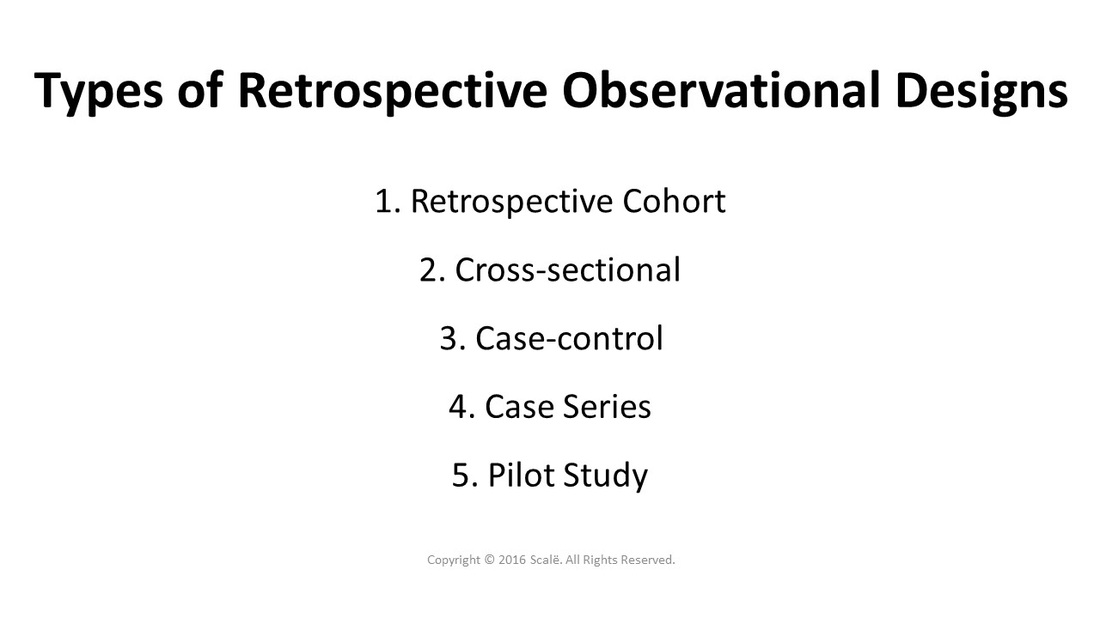Retrospective research designs
Retrospective research designs are used when the outcome has already occurred
Retrospective observational designs are used when the outcomes of interest have already occurred. Retrospective observation studies are very feasible in terms of scope, resources, and time. These designs cannot yield causal effects because of the absence of random selection and random assignment. All that can be established in regards to evidence in retrospective observational designs are associations between predictor and outcome variables.
There are certain instances where these designs should be employed. Case series designs are basic science projects where hypotheses are generated and effect sizes are established. Case-control designs should be employed for very rare outcomes and hypothesis generation. Because of the amount of observation and selection bias associated with selecting control participants and using existing data, case series and case-control designs yield the lowest levels of empirical evidence. However, if a researcher is traversing new empirical territory or looking for potential predictors of disease states, these designs are feasible. Pilot studies with at least 150-300 participants or observations can establish effect sizes for conducting a priori sample size calculations for higher-level studies.
There are certain instances where these designs should be employed. Case series designs are basic science projects where hypotheses are generated and effect sizes are established. Case-control designs should be employed for very rare outcomes and hypothesis generation. Because of the amount of observation and selection bias associated with selecting control participants and using existing data, case series and case-control designs yield the lowest levels of empirical evidence. However, if a researcher is traversing new empirical territory or looking for potential predictors of disease states, these designs are feasible. Pilot studies with at least 150-300 participants or observations can establish effect sizes for conducting a priori sample size calculations for higher-level studies.
Cross-sectional designs establish the prevalence of a disease state or phenomenon in a given population. Prevalence is an important statistic because it gives a snapshot of how something is perceived or experienced in a population. Cross-sectional survey designs are often used to measure for unique and abstract concepts.
The retrospective cohort design is the most powerful retrospective observational design in terms of the evidence yielded. They test associations associated with exposures and outcomes and can be used to assess temporal components of disease states.
The retrospective cohort design is the most powerful retrospective observational design in terms of the evidence yielded. They test associations associated with exposures and outcomes and can be used to assess temporal components of disease states.
Types of retrospective observational designs
Retrospective cohort designs yield measures of relative risk and also establishes longitudinal and etiological data about disease states.
Cross-sectional designs generate measures of prevalence of an outcome in a population.
Case-control designs are used to study rare disease states and for testing hypothesized associations between outcomes and potential predictors of disease.
Case series designs are used for hypothesis generation and pilot studies.
A pilot study is used when there is no measure of effect size available for sample size calculations.
Hire A Statistician
DO YOU NEED TO HIRE A STATISTICIAN?
Eric Heidel, Ph.D., PStat will provide you with statistical consultation services for your research project at $100/hour. Secure checkout is available with Stripe, Venmo, Zelle, or PayPal.
- Statistical Analysis on any kind of project
- Dissertation and Thesis Projects
- DNP Capstone Projects
- Clinical Trials
- Analysis of Survey Data

